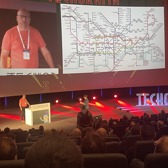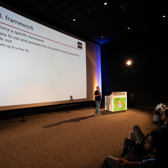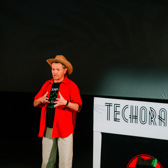Developing AI-Powered Apps with C# and Azure AI
UADAI
4 days
Interested in a private company training? Request it here.
Not ready to book yet? Request an offer here.
What is Artificial Intelligence?
In this chapter you will get a short overview about what AI is exactly, and what we can do with it.
- Definitions of Artificial Intelligence
- Machine Learning Basics
- Domains of Artificial Intelligence
- History, Current State and Future
Introduction to Microsoft Foundry
Microsoft Foundry is a comprehensive platform that streamlines AI solution development and deployment. In this chapter, discover how to use hubs for building and testing AI solutions, projects for grouping and deploying AI apps, and tools for managing resources, all while ensuring responsible AI practices are followed.
- What is Microsoft Foundry?
- Collaborative AI Development
- Developing and Testing AI Solutions in Hubs
- Deploying AI Applications with Projects
- Managing Resources and Projects
- LAB: Creating an Microsoft Foundry Hub
Ready-to-Use AI Models with Azure AI Services
Azure AI services provides a comprehensive suite of out-of-the-box and customizable AI tools, APIs, and pre-trained models that detect sentiment, recognize speakers, understand pictures and many more. Microsoft Foundry brings together these services into a single, unified environment.
- Azure AI Services Overview
- Azure AI Language
- Azure AI Vision
- Azure AI Speech
- Azure AI Document Intelligence
- LAB: Creating an AI Powered Insurance Claim Processor
Azure OpenAI and Large Language Model Fundamentals
This module introduces Azure OpenAI and the GPT family of Large Language Models (LLMs). You'll learn about available LLM models, how to configure and use them in the Azure Portal, and the Transformer architecture behind models like GPT-4o. The latest GPT models offer Function Calling, enabling connections to external tools, services, or code, allowing the creation of AI-powered Copilots. Additionally, you'll discover how Azure OpenAI provides a secure way to use LLMs without exposing your company's private data.
- Introducing OpenAI and Large Language Models
- The Transformer Model
- What is Azure OpenAI?
- Configuring Deployments
- Understanding Tokens
- LLM Pricing
- Azure OpenAI Chat Completions API
- Role Management: System, User and Assistant
- Azure OpenAI SDK
- Extending LLM capabilities with Function Calling
- LAB: Deploying and Using Azure OpenAI
Modern .NET AI Development with Microsoft Extensions AI
Microsoft Extensions AI is a set of core libraries providing a unified layer of abstractions for interacting with AI services. It enables developers to integrate Large Language Models (like OpenAI, Azure OpenAI, or local models via Ollama) into .NET applications using consistent, standardized interfaces. This package focuses on composable building blocks, allowing you to easily chain middleware for logging, caching, and telemetry while interacting with your custom code.
- An Introduction to Microsoft Extensions AI
- Unified Integration with AI Interfaces
- Monitoring Costs and Token Usage
- Invoking Code with Tool Calling
- Modifying Behavior with AI Middleware
- Dependency Injection for AI Services
- Observable AI Apps with OpenTelemetry
- LAB: Create a Natural Language to SQL Translation Copilot
Model Context Protocol (MCP): Standardizing LLM Integrations
This chapter explores the Model Context Protocol (MCP), an open standard revolutionizing how applications provide context to LLMs. MCP acts as a 'USB-C for AI,' standardizing connections between LLMs and various data sources or tools. Crucially, MCP empowers companies to define, once and for all, precisely how their proprietary data and tools are utilized by AI systems.
- What is the Model Context Protocol (MCP)?
- Understanding MCP's Core Components: Hosts, Clients and Servers
- Defining MCP Prompts, Tools and Resources
- Building MCP Servers with C#
- LAB: uilding MCP Servers and Client with C#
Retrieving Semantically Related Data with Vector Search
Vector search is a powerful technique that allows you to retrieve semantically related data from large datasets such as company documents or databases. This chapter will teach you how vector search works and how it enables you to find relevant information without depending on exact keyword based search terms or language of the information in the dataset.
- Capture Semantic Meaning with Embeddings
- Vector Search
- Vector Search Design Considerations
- LAB: Using Vector Embeddings and Semantic Search
Using your own data in a LLM with Azure AI Search
Azure AI Search facilitates the adoption of the Retrieval Augmented Generation (RAG) design pattern. This methodology involves retrieving pertinent information from a data source and using it to increase the knowledge of generative AI models.This combination of retrieval and generation sets a new standard for AI-driven search solutions.
- What is Azure AI Search?
- Retrieval Augmented Generation
- Creating an Index on your Own Data
- AI Enrichment with your own Data
- Using the Azure OpenAI SDK
- Privacy Concerns
- Fine-tuning vs RAG
- LAB: Chat with Azure OpenAI models using your own data
Prompt Engineering and Design Patterns
In this chapter, you'll explore advanced techniques allowing you to control the model's output, transforming generic responses into precise, valuable results. Additionally the chapter covers emerging design patterns in the field of Gen AI app development that help you increase quality of model responses and reduce costs.
- What is Prompt Engineering?
- Few-Shot Prompting
- Structured Query Generation
- Verifying Model responses with Hallucination Detection
- Saving costs with Semantic Caching
Building Agentic AI Systems with Microsoft Agent Framework
This chapter introduces the fundamentals of building agentic AI systems, with a focus on the Microsoft Agent Framework. You will learn what agents are, when they are the right architectural choice, and how the Agent Framework helps structure agent behavior using models, tools, instructions, and memory. The chapter also explores common orchestration patterns and emphasizes the importance of guardrails, safety, and human-in-the-loop oversight for building reliable and responsible agent-based solutions.
- Introduction to Agentic AI Systems
- Identifying Ideal Use Cases for Agents
- Core Principles of Agent Design (Models, Tools, Instructions)
- Building Agents with the Microsoft Agent Framework
- Orchestrating Agent Workflows: Single and Multi-Agent Approaches
- Implementing Guardrails for Safe and Reliable Agents
- Integrating Human Oversight and Intervention Strategies
- LAB: Building a Multi-Agent Application
Deploying AI Models on Microsoft Foundry
The cost and quality of your AI-powered app depend largely on your choice of AI model and how you deploy it. Learn about the available model catalog, featuring state-of-the-art Azure OpenAI models and open-source models from Hugging Face, Meta, Google, Microsoft, Mistral, and many more.
- Model Catalog Overview
- Model Benchmarks
- Selecting the Best Deployment Mode
- LAB: Deploying an Open Source AI Model on Microsoft Foundry
Working with Open-Source Language Models
This chapter empowers you to bring powerful AI capabilities to end-user environments like mobile devices, personal computers and browsers, enhancing scalability, costs and performance. Additionally you will learn how to deploy and host your own open-source Language Models in the form of an API that you have full control over.
- The Phi-3 Family of Small Language Models
- Deploying AI Models on Mobile and Edge Devices with ONNX Runtime
- Hosting and Deploying Language Models on-prem and in the cloud with Ollama
Testing and Moderating AI Models with Microsoft Foundry
How can you ensure an LLM provides relevant and coherent answers to users' questions using the correct info? How do you prevent an LLM from responding inappropriately? Discover the answers to these questions and more by exploring evaluation metrics in Microsoft Foundry and the Azure AI Content Safety Service.
- Ensuring Coherent and Relevant LLM Responses
- Utilizing Correct Information in AI Answers
- Using Microsoft Foundry's built-in Evaluators
- Preventing Inappropriate LLM Responses
- Leveraging Azure AI Content Safety Service
- Enhancing AI Performance and Safety
- LAB: Evaluating the Performance of a RAG App
In this course, you will learn to seamlessly integrate pre-built AI services and Large Language Models such as ChatGPT and Phi into your .NET development projects. You will become familiar with Microsoft Foundry, Microsoft's unified portal for managing, testing, moderating and deploying AI models. The course will teach you how to use your own data with Large Language Models using Azure AI Search. Furthermore, you will gain hands-on experience with AI libraries such as Semantic Kernel. This course will equip you with the skills to integrate advanced AI capabilities into your software solutions without needing to be a data scientist.
This course targets professional C# developers that want to get started with the Microsoft AI platform, now known as Microsoft Foundry. Participants of this course need to have a decent understanding of C# and preferably some experience with Microsoft Azure. This is not a course for data scientists who want to build their own AI models or understand how existing AI models work.










